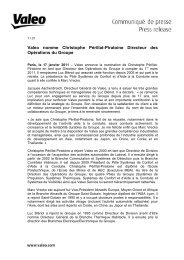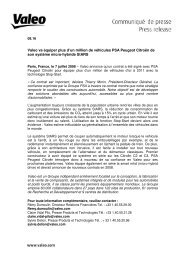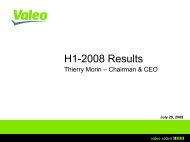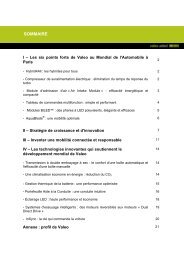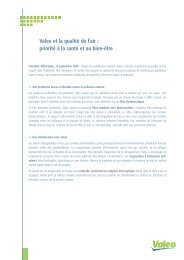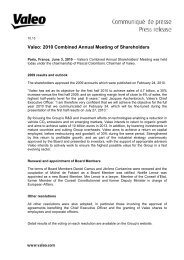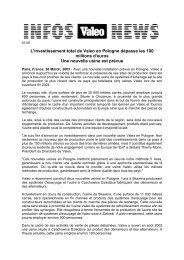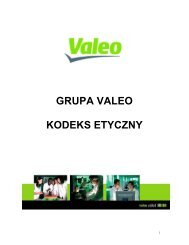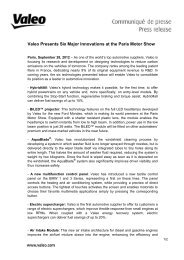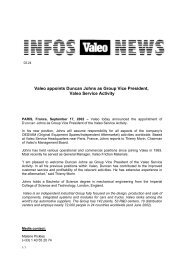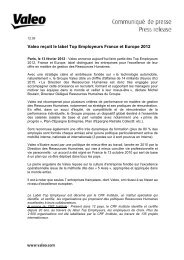2007 Reference document (PDF) - Valeo
2007 Reference document (PDF) - Valeo
2007 Reference document (PDF) - Valeo
Create successful ePaper yourself
Turn your PDF publications into a flip-book with our unique Google optimized e-Paper software.
The proportionate consolidation method is used when the contractual<br />
arrangements for control of a company specify that it is under the joint<br />
control of the two venturers. Companies of this type are called joint<br />
ventures. In this case, the Group’s share of each asset and liability and<br />
each item of income and expense is aggregated, line-by-line, with<br />
similar items in its consolidated financial statements.<br />
All significant inter-company transactions are eliminated (for joint<br />
ventures the elimination is performed to the extent of the Group’s<br />
ownership interest in the company), as are gains on inter-company<br />
disposals of assets, inter-company profits included in inventories and<br />
inter-company dividends.<br />
Companies over which <strong>Valeo</strong> exercises significant influence are<br />
accounted for by the equity method. <strong>Valeo</strong> is considered to exercise<br />
significant influence over companies in which the Group owns<br />
more than 20% of the voting rights. The equity method consists of<br />
replacing the book value of the investments by the Group’s equity in<br />
the associate’s underlying net assets, including goodwill.<br />
Companies acquired during the year are consolidated as from the<br />
date at which the Group exercises (sole or joint) control or significant<br />
influence.<br />
1.4. Foreign currency translation<br />
Each Group company maintains its accounting records in its functional<br />
currency. A company’s functional currency is the currency of the<br />
principal economic environment in which it operates, generally being<br />
the local currency.<br />
Transactions carried out in a currency other than the company’s<br />
functional currency are translated using the exchange rate prevailing<br />
at the transaction date. Monetary assets and liabilities denominated<br />
in foreign currency are translated at the year-end exchange rate.<br />
Non-monetary assets and liabilities denominated in foreign currency<br />
are recognized at the historical exchange rate prevailing at the<br />
transaction date. Differences arising from the translation of foreign<br />
currency transactions are recognized in income, with the exception of<br />
differences relating to loans and borrowings which are in substance<br />
an integral part of the net investment in a foreign subsidiary. These<br />
are recorded, for their amount net of tax, in consolidated stockholders’<br />
equity under translation reserves until the net investment is disposed<br />
of, at which time they are recognized in income.<br />
The financial statements of foreign subsidiaries whose functional<br />
currency is not the euro are translated into euros as follows:<br />
■<br />
■<br />
assets and liabilities are translated at the year-end exchange rate;<br />
income statement items are translated into euros at the exchange<br />
rates applicable at the transaction dates or, in practice, at the<br />
average exchange rate for the period, as long as this is not rendered<br />
■<br />
Consolidated fi nancial statements at December 31, <strong>2007</strong><br />
Notes to consolidated financial statements<br />
inappropriate as a basis for translation by major fluctuations in<br />
exchange rates during the period;<br />
unrealized gains or losses arising from the translation of the<br />
financial statements of foreign subsidiaries are recorded through<br />
stockholders’ equity.<br />
1.5. Operating revenues<br />
< Contents ><br />
Operating revenues are comprised of net sales and other operating<br />
revenues.<br />
Net sales primarily include sales of finished goods and also include<br />
all tooling revenues. Sales of finished goods and tooling revenues are<br />
recognized at the date on which the Group transfers substantially all<br />
the risks and rewards of ownership to the buyer and no longer retains<br />
continuing managerial involvement nor effective control over of the<br />
goods sold. In cases where the Group retains control of the future<br />
risks and rewards related to tooling, any customer contributions are<br />
recognized over the duration of the project, over a maximum period<br />
of four years.<br />
Other operating revenues consist of all revenues for which the<br />
associated costs are recorded below the gross margin line. They<br />
mainly comprise sales of prototypes and contributions received from<br />
customers to development costs. Such contributions are deferred as<br />
appropriate and are taken to income over the period of sale of the<br />
corresponding products, within a maximum period of four years.<br />
1.6. Gross margin and operating income<br />
Gross margin is defined as the difference between net sales and<br />
cost of sales. Cost of sales primarily corresponds to the cost of goods<br />
sold.<br />
Operating income includes all income and expenses other than:<br />
■ interest paid on debt and interest earned on cash and cash<br />
equivalents;<br />
■ other financial income and expenses;<br />
■ equity in net earnings of associates;<br />
■ income taxes;<br />
■ income/(loss) from non-strategic activities (“discontinued<br />
operations” under IFRS 5).<br />
In order to facilitate interpretation of the statement of income and of<br />
Group performance, unusual items that are material to the consolidated<br />
financial statements are presented separately within operating income<br />
under “Other income and expenses”.<br />
<strong>2007</strong> <strong>Reference</strong> <strong>document</strong> - VALEO<br />
3<br />
PAGE 87<br />
1<br />
2<br />
3<br />
4<br />
5<br />
6




